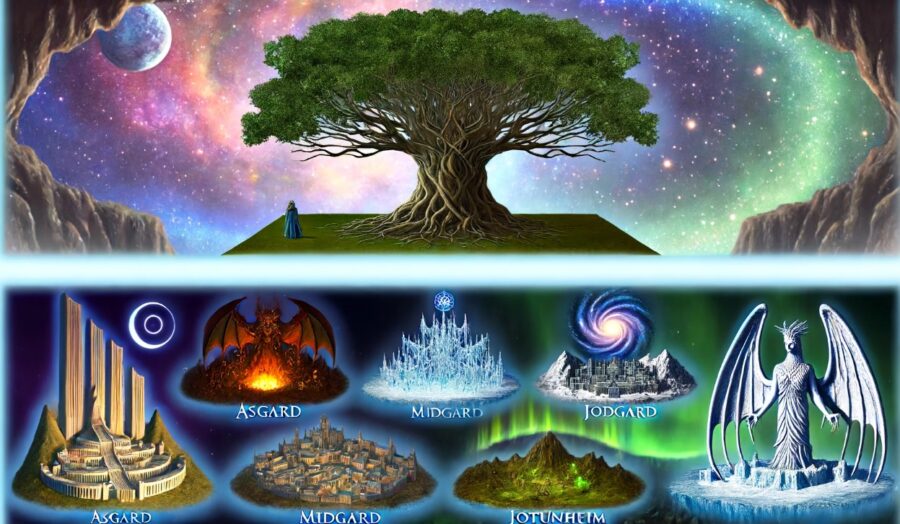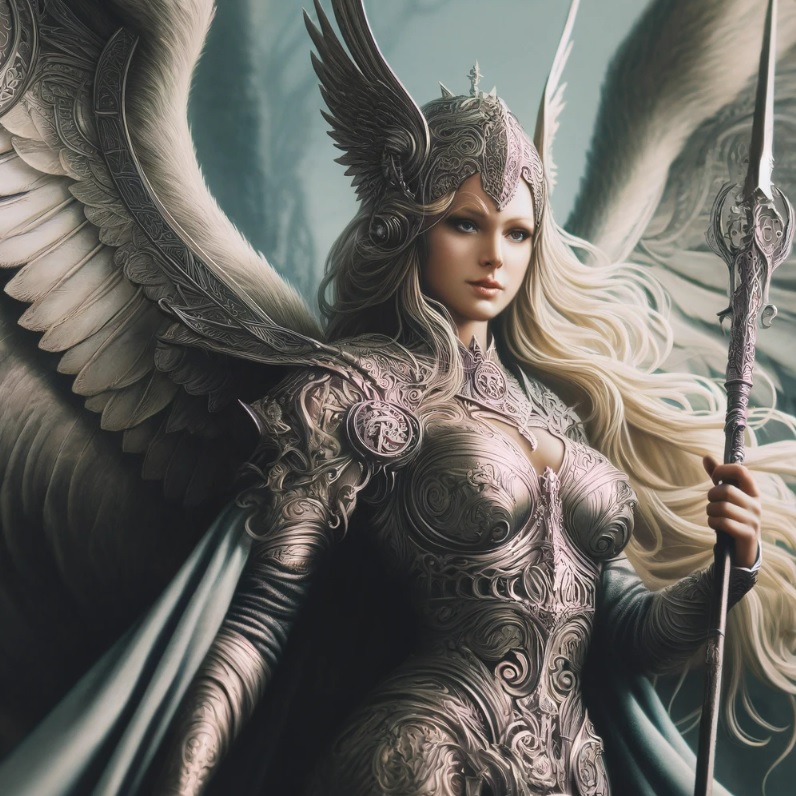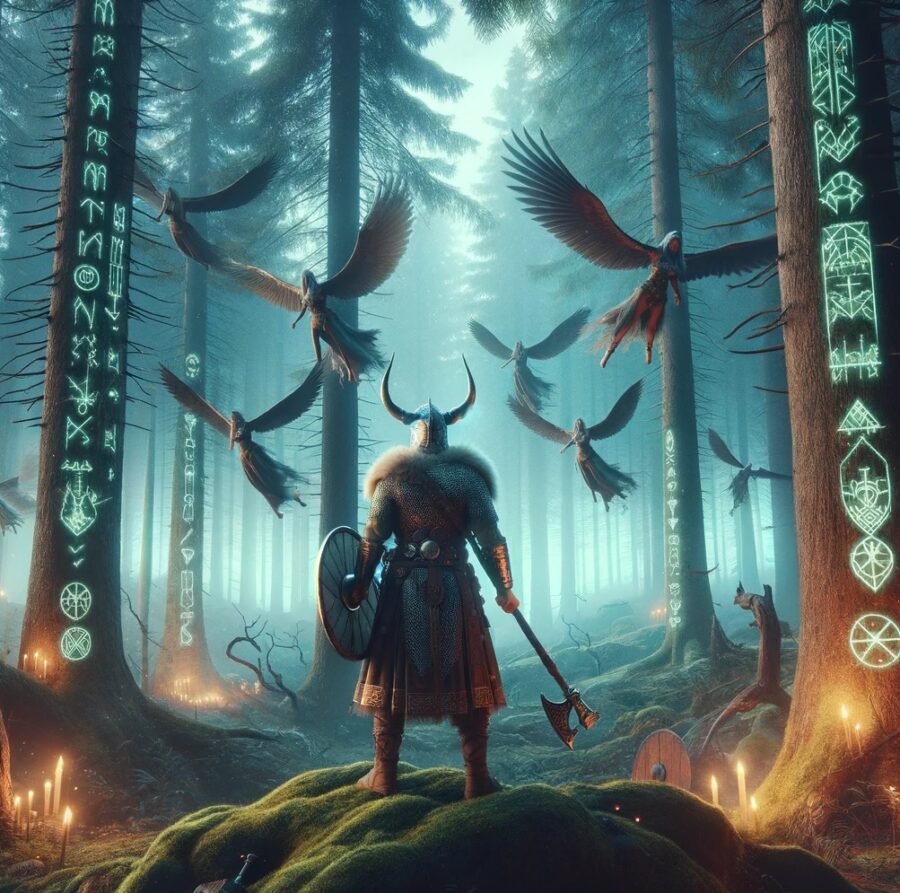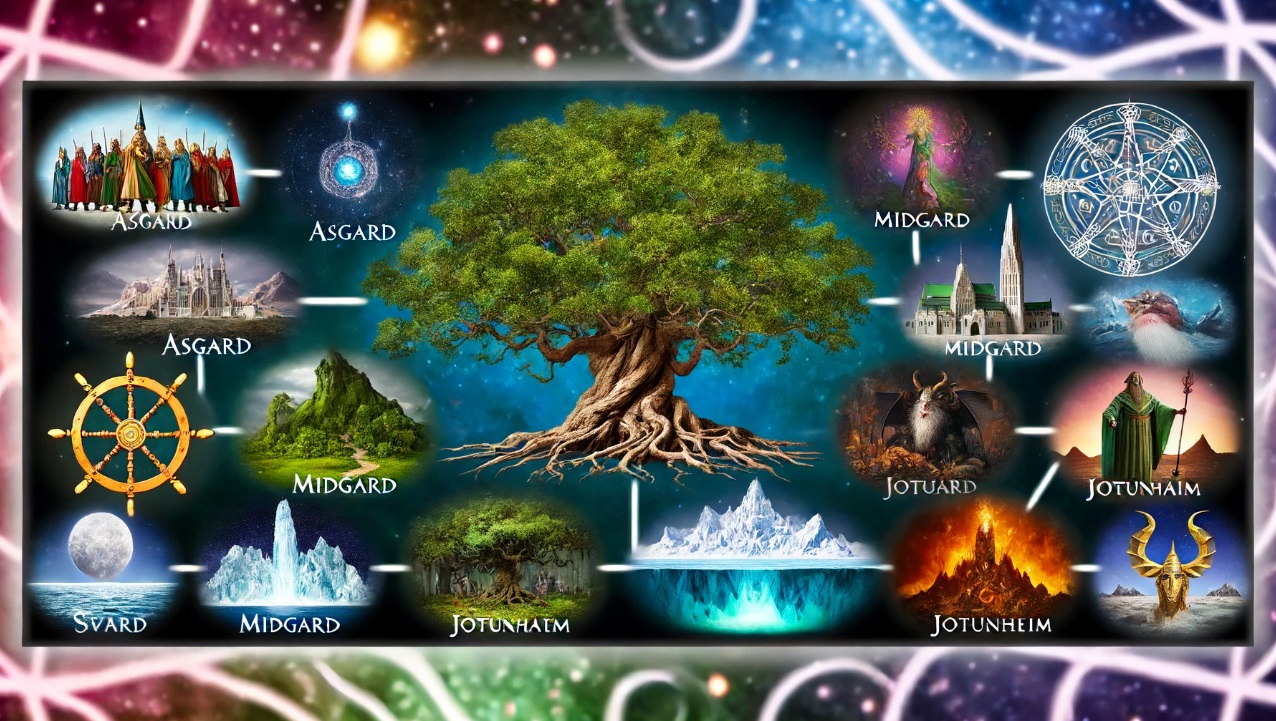NordenBladet – Norse mythology is a rich and complex web of beliefs, gods, and creatures that played a significant role in the lives of the Scandinavian people. The Norse cosmos was divided into nine different realms, each with its own unique characteristics, inhabitants, and stories. In this article, we will explore the nine realms of Norse mythology and gain a deeper understanding of the ancient Norse worldview.
In Norse mythology, the nine realms were not just physical places but also represented different aspects of the universe and the human experience. For example, Midgard represented the human world and the experiences of humans, while Asgard represented the divine and the experiences of the gods.
The Norse cosmos was also believed to be constantly in motion, with the realms constantly interacting and influencing each other. For example, the events in Midgard would affect the gods in Asgard, and vice versa.
The Norse gods were not immortal, and their fate was ultimately linked to the fate of the cosmos. In the end, the Norse believed that the world would come to an end in a great battle called Ragnarok, where the gods would fight the giants and the forces of chaos.
Another important aspect of Norse mythology was the concept of fate, known as the Norns. The Norns were three goddesses who were said to spin the thread of fate and determine the course of individual lives and the world as a whole.
The Norse people also believed in reincarnation, and that after death, the soul would be reincarnated into another body. This cycle of reincarnation was seen as a way for the soul to continue learning and growing until it was finally able to reach Valhalla and live with the gods.
The nine realms of Norse mythology were not just physical places, but also represented different aspects of the universe and the human experience. The Norse worldview was rich and complex, encompassing ideas of fate, reincarnation, and the interaction between the gods and humans. These beliefs and myths continue to captivate and inspire people to this day.
The nine relams:

Image depicting Norse mythology, showcasing the nine distinct realms interconnected by the ash tree Yggdrasil (Illustrations by NordenBladet)
Asgard:
Asgard (Old Norse: Ásgarðr) is the realm of the gods, the home of Odin, Thor, and the other Aesir gods. It is located in the highest part of the cosmos and is said to be surrounded by a rainbow bridge called Bifröst. Asgard was a place of great beauty and prosperity, where the gods lived in magnificent halls and feasted on the flesh of the goat Heidrun.
Valhalla (Valhǫll) is the great hall of the god Odin, located in Asgard. It is where the bravest and most honored warriors who died in battle would go after they died, and where they would train and prepare for the final battle of Ragnarok.
In Valhalla, the warriors would live a life of constant feasting, fighting, and revelry, forever honored and remembered by the gods and other warriors. The idea of Valhalla was a source of great comfort and inspiration for the Norse people, who valued bravery and honor in battle above all else.
It was also believed that the warriors who went to Valhalla would be chosen by the Valkyries, female warriors who would ride over the battlefield and select the bravest warriors to bring to Valhalla. This idea was a source of great fascination and inspiration for the Norse people, and the Valkyries remain an important part of Norse mythology and culture to this day.

Valkyrie (Illustrations by NordenBladet)

Viking (Illustrations by NordenBladet)
Folkvangr is a hall in Norse mythology, often associated with the goddess Freyja. It is believed to be located in Asgard and is said to be one of the nine realms of Norse cosmology.
In Norse mythology, Freyja was the goddess of love, fertility, and war, and was considered to be one of the most powerful and beloved of all the gods and goddesses. Folkvangr was her dwelling place and was said to be a place of great beauty and splendor, where Freyja would receive half of the souls of those who died in battle.
The idea of Folkvangr was a source of great fascination and inspiration for the Norse people, and Freyja remains one of the most popular and beloved figures in Norse mythology to this day. Folkvangr was seen as a place of honor and reward for the brave warriors who died in battle, and as a place of comfort and solace for their loved ones who remained behind.
Vanaheim:
Vanaheim was the home of the Vanir gods, a different tribe of gods than the Aesir. The Vanir were associated with fertility, the harvest, and the natural world. The goddess Freya was one of the most famous Vanir, known for her love of beauty and her ability to control the minds of men. Vanaheim was a peaceful realm, where the Vanir lived in harmony with nature and each other.
Svartalfheim (Nidavellir):
Svartalfheim was the realm of the dwarves, a race of skilled craftsmen who lived underground. The dwarves were said to be able to forge magical items and were often sought after by the gods for their talents. The dwarves were also known for their love of gold and their great wealth.
Midgard (Miðgarðr):
Midgard was the realm of humans, located in the center of the Norse cosmos. It was said to be surrounded by an ocean and was the only realm accessible to humans. Midgard was a place of great turmoil and change, where humans lived and died and the forces of nature were constantly at work.
Alfheim:
Alfheim was the realm of the elves, a race of beings known for their beauty, grace, and magic. The elves were said to be light and joyful creatures, who lived in harmony with nature and were the guardians of the natural world. Alfheim was a place of great beauty, where the elves lived in peace and prosperity.
Jotunheim (Jǫtunheimr):
Jotunheim was the realm of the giants, a race of beings known for their great size and strength. The giants were often in conflict with the gods, who saw them as a threat to their power and control. Jotunheim was a place of great danger, where the giants lived and plotted against the gods.
Muspelheim (Múspellsheimr):
Muspelheim was the realm of fire, a place of great heat and light. The giant Surt was said to rule over Muspelheim, and it was believed that the fire of Muspelheim would eventually consume the world. Muspelheim was a place of both destruction and creation, where the flames gave birth to new life and consumed all that was old.
Niflheim (Niflheimr):
Niflheim was the realm of ice, a place of cold and darkness. The goddess Hel was said to rule over Niflheim, and it was believed that the dead who did not die in battle would end up in this frozen underworld. Niflheim was a place of death and decay, where the cold winds and ice forever chilled the souls of the dead.
Hel (Helheim):
Helheim was the underworld, a place of darkness and decay, where the dead who did not die in battle went after. In Norse mythology it is associated with death, the underworld, and the afterlife. It was believed to be located in the far northern regions, beyond the realm of Midgard.
In Norse mythology, Hel was the daughter of Loki and the giantess Angrboda. She was depicted as a half-dead, half-alive figure with a pale complexion and was said to rule over the dead in the underworld. The souls of those who did not die in battle and did not go to Valhalla or Folkvangr were believed to go to Hel after they died.
In Norse cosmology, Hel was considered to be a place of punishment for the wicked and the damned, where they would spend eternity in cold and darkness. However, it was also believed that some souls could be redeemed and eventually leave Hel and go to a better afterlife.
The idea of Hel was a source of great fear and fascination for the Norse people, who believed that death was not the end, but rather a journey to the afterlife. Hel remains an important part of Norse mythology and continues to be a symbol of death, the underworld, and the afterlife to this day.
Image: In Norse mythology, the structure of the universe is organized into nine distinct realms that are interconnected by the ash tree Yggdrasil. The nine worlds were Asgard, Midgard, Jotunheim, Niflheim, Muscenters, Helheim, Alfheim, Svartalfheim, and Vanaheim. (Illustrations by NordenBladet)
